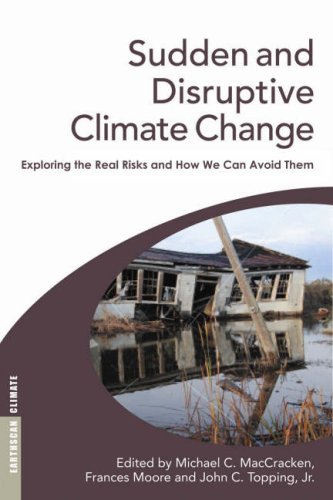(Ebook PDF) Sudden and Disruptive Climate Change Exploring the Real Risks and How We Can Avoid Them 1st edition by Michael Maccracken isbn 9781136556364 1136556362 full chapters
$50.00 Original price was: $50.00.$35.00Current price is: $35.00.
Sudden and Disruptive Climate Change Exploring the Real Risks and How We Can Avoid Them Michael C. Maccracken Digital Instant Download
Author(s): Michael C. MacCracken, Frances Moore, John C. Topping Jr
ISBN(s): 9781844074785, 1844074781
Edition: illustrated edition
File Details: PDF, 4.71 MB
Year: 2008
Language: english
SKU: EB-1370218
Category: Engineering
Tags: Frances Moore, John C. Topping Jr, Michael C. MacCracken
(Ebook PDF) Sudden and Disruptive Climate Change Exploring the Real Risks and How We Can Avoid Them 1st edition by Michael Maccracken-Ebook PDF Instant Download/Delivery:9781136556364, 1136556362
Instant download Full Chapter of Sudden and Disruptive Climate Change Exploring the Real Risks and How We Can Avoid Them 1st edition after payment

Product details:
ISBN 10:1136556362
ISBN 13:9781136556364
Author: Michael Maccracken
‘An impressive accomplishment. Al Gore, Former Vice President of the US, co-recipient of the 2007 Nobel Peace Prize, and author of An Inconvenient Truth Offers positive solutions that no rational person, organization or government can ignore – except at their peril. Stephen H. Schneider, Professor for Interdisciplinary Environmental Studies, Stanford University, and author of The Genesis Strategy: Climate and Global Survival The science is clear and the message of this book is that there is no more time for delay. Rosina M. Bierbaum, Dean, University of Michigan While changes in emissions and atmospheric concentrations of greenhouse gases are projected to be slow and smooth, the intensity and impacts of climate change on the environment and society could be abrupt and erratic. Surprising and nonlinear responses are likely to occur as warming exceeds certain thresholds, inducing relatively rapid and disruptive changes in the Greenland and West Antarctic ice sheets, precipitation intensity and patterns, coastal inundation, the occurrence of wildfire, the ranges of plant and animal species and more. Written by a transdisciplinary group of internationally respected researchers, this book explores the possibilities of such changes, their significance for society and efforts to move more rapidly to limit climate change than current government measures.
Table of Contents:
- Part 1 The Potential for Rapid Changes to the Weather and Climate
- Introduction to Part 1
- 1 Ten Reasons Why Climate Change May be More Severe than Projected
- New Evidence Suggesting More Rapid Climate Change
- 1 The Climate Sensitivity may be Larger than has been Traditionally Estimated
- 2 Global Dimming is Large but Decreasing
- 3 Permafrost Melting and Albedo Changes
- 4 Biomass Feedbacks are Kicking in
- 5 Arctic Sea Ice is Retreating Rapidly
- 6 Changes in Air and Sea Circulation in Middle and High Latitudes
- 7 Rapid Changes in Antarctica
- 8 Rapid Melting and Faster Outlet Glaciers in Greenland
- 9 Tropical Cyclones may Already be more Intense
- 10 Variations in North Atlantic Ocean Circulation and Salinity
- Discussion
- Notes
- References
- 2 Potential Increased Hurricane Activity in a Greenhouse Warmed World
- Linkage to Increased Tropical Sea Surface Temperature
- Attribution of the Increased Hurricane Activity
- Projections of Future Hurricane Activity in the North Atlantic
- Impacts and Policy Responses
- References
- 3 Potential Effects of Weather Extremes and Climate Change on Human Health
- Impacts on Nutrition and the Food Supply
- Health Impacts from Heat Stress and Air Pollution
- Impacts on Water and Food-borne Diseases
- Health Impacts Resulting from International Interconnections
- Conclusion
- References
- Part 2 The Potential for Rapid Melting of Ice and Amplification of Sea Level Rise
- Introduction to Part 2
- 4 Changes in Polar Sea Ice Coverage
- The Extent and Influence of Polar Sea Ice
- The Arctic Record
- The Antarctic Record
- Discussion
- Acknowledgements
- References
- 5 Changes in the Greenland Ice Sheet and Implications for Global Sea Level Rise
- Ice sheet changes
- Mass Balance Estimates
- What is Causing these Changes?
- What can be Predicted?
- Are these Changes Significant over the Longer Term?
- Conclusions
- References
- 6 Why Predicting West Antarctic Ice Sheet Behavior is so Hard: What We Know, What We Don’t Know and How We Will Find Out
- Understanding Ice Sheet Behavior
- State of the Ice Sheets
- Feedback Mechanisms that could Accelerate Melting
- Discussion
- Notes
- References
- Part 3 The Potential for Dramatic Changes in Coastal Regions
- Introduction to Part 3: The Honorable Tom Roper
- 7 The Potential for Significant Impacts on Chesapeake Bay from Global Warming
- Sea Level Rise and its Impacts
- Submergence, Shore Erosion, Storm Flooding and Waves
- Ecological Impacts
- Coastal Marsh Loss and its Effects
- Impacts of Increasing Water Temperatures and Salinity
- The Challenge of Global Warming to the Chesapeake Bay
- References
- 8 The Northern Gulf of Mexico Coast: Human Development Patterns, Declining Ecosystems and Escalating Vulnerability to Storms and Sea Level Rise
- Gulf Coast Physiographic Setting
- Human Development Activities and Impacts
- Sea Level Rise and Subsidence
- Tropical Storms
- Conclusions
- References
- 9 Threats and Responses Associated with Rapid Climate Change in Metropolitan New York
- Characteristics of Tropical and Extra-tropical Storms in the Metropolitan Region
- Possible Responses to Increasing Risk from Accelerating Sea Level Rise
- Storm Surge Barriers for Metropolitan New York
- The Stony Brook Storm Surge Models
- Storm Surge Barriers: The European Experience
- Thames River Barrier, London
- Storm Surge Barriers: The New England Experience
- Stamford, Connecticut
- Providence, Rhode Island
- New Bedford, Massachusetts
- What can we Learn from Experiences of Existing Barriers?
- Would Storm Surge Barriers be Cost Effective?
- How High would the Barriers and Seawalls need to be? How Long would they be Designed to Last?
- Are Storm Surge Barriers Reliable and Fail-safe?
- What are the Downsides of an Engineering Solution? Are we only Delaying the Inevitable Catastrophe?
- When Might the City of New York Start Planning for Barriers?
- Conclusions
- Acknowledgements
- Note
- References
- 10 Increasing the Resilience of Our Coasts: Coastal Collision Course of Rising Sea Level, Storms, Coastal Erosion and Development
- Climate Change and Coastlines
- Reducing Coastal Risk
- New Technology to Improve Coastal Resilience
- Conclusions
- Acknowledgement
- Notes
- References
- 11 Preparing and Protecting American Families from the Onslaught of Catastrophe
- We Continue to Face the Likelihood of Natural Catastrophes
- Our Preparedness for Responding needs Enhancement
- Conclusion
- References
- Part 4 The End of Evolution? The Potential for Rapid Changes in Ecosystems
- Introduction to Part 4
- 13 Increasing Vulnerability of Alaska’s Boreal Forest as a Result of Climate Warming and the Changing Fire Regime
- Variation in Fire Severity and its Effects on Ecosystem Characteristics
- Recent changes to the Fire Regime and Permafrost
- Vulnerability of Alaska’s Black Spruce Forests
- Effects of Forest Cover change on Ecosystem Services and Society
- Conclusions
- Acknowledgements
- References
- 14 Polar Bears in a Warming Arctic
- Polar Bear Survival
- Status of Polar Bear Populations
- Changes in Polar Bear Habitat
- Effects of Future Warming on Polar Bear Populations and other Arctic Species
- Conclusions
- References
- Part 5 The Potential for Accelerating Action to Limit Climate Change
- Introduction to Part 5
- 15 International Action to Buffer Against the Rapid Onset of Climate Change
- Increasing International Awareness
- Political Acceptance of Climate Change
- Addressing and Slowing the Consequences of Climate Change
- Conclusions
- References
- 16 A Moral and Profitable Path to Climate Stabilization
- Corporate Involvement
- Energy
- Transportation
- Technology and Industry
- Financial
- Green Companies do Better
- A Role for Government
- State Initiatives
- California and Hydrogen Power
- International Efforts
- Brazil
- Europe
- Conclusions
- References
- 17 Moving Toward Climate Stabilization: Iceland’s Example
- Progress in Iceland
- Progress across the North
- Iceland is Taking Actions to Address Climate Change
- 18 Climate Impacts in the Developing World: A Case Study of the Small Island States
- Climate Change and the Small Island Developing States
- GSEII in the Caribbean
- GSEII in the Pacific
- Implications for Developing Nations
- References
- 19 Stimulating a Clean Energy Revolution
- The Current Renewables Boom
- US Potential for Renewable Energy
- Conclusions
- References
- 20 Recycling Energy to Reduce Costs and Mitigate Climate Change
- The Economics of Decentralization
- Energy Markets are not Free
- Policy Options to Encourage Recycled Energy
- Conclusions
- Notes
- References
- 21 Addressing Climate Change: Religious Perspectives and Initiatives
- A Jewishnse to Climate Change (Rabbi Warren G. Stone)
- A Muslim Perspective (Khalid Shaukat)
- A Mormon Perspective (Joseph Cannon)
- A Catholic Perspective (Walt Grazer)
- Green Leadership in the Religious Community (Rev. Sally Bingham)
- Presbyterians move toward Climate Neutrality (Pam McVety)
- Evangelical actions to Build Climate Protection into Overseas Ministry (Jo Anne Lyon)
- Concluding Thought
- 22 Climate Solutions on Today’s Campuses: How Today’s Students Must Drive a Modern Industrial Revolution
- Historic Context: University Roots Run Deep
- Taking Action on Energy: Stepping up to the Challenge and Driving a Shift in Power
- How Climate-negative Campuses will drive a Modern Industrial Revolution
- Campus Climate Neutral
- National Neutrality: American College & University Presidents Climate Commitment
- Crimson & Platinum
- Sending out an SOS: ASU’s School of Sustainability
- What’s Law got to do with it?
- Driving a Modern Industrial Revolution (Project MIR)
- Conclusions
- Notes
- References
- 23 Strategies for Greenhouse Gas Emissions Reductions: The Role of Greenhouse Gas Offsets
- Early Actions
- Greenhouse Gas Offsets and their Benefits
- Greenhouse Gas Offsets and Regulatory Policy
- The Voluntary Greenhouse Gas Market
- The Importance of Offset Quality
- Conclusions
People also search:
sudden climate change
sudden environmental change examples
sudden environmental change
sudden environmental change definition
climate change disruption
Tags:
Michael Maccracken,Sudden,Disruptive Climate Change,Real Risks


